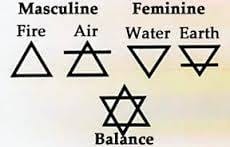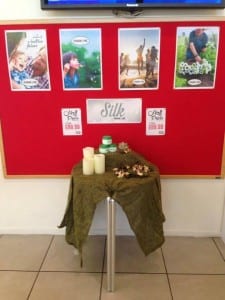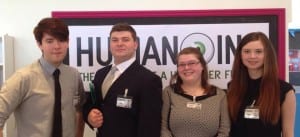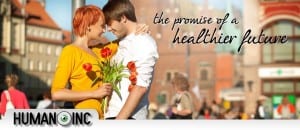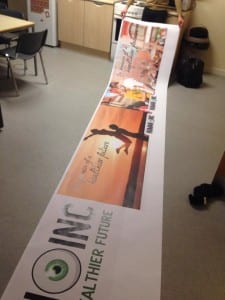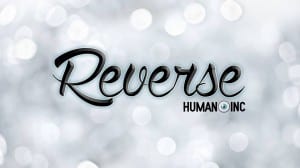On the 10th of May, Human.Inc set up in Zing Café to conduct a market research questionnaire for their new product ‘Reverse’, an anti age skin cream that they have formulated. Here they ask volunteers’ basic questions about their current approach towards health/beauty products, where they prefer to buy them, what is it that appeals to them the most, their price range for products etc. After hearing about the new product ‘Reverse’ they would be asked of their opinion on the product and thing that would help the company greatly, they would then be offered a free sample bottle of ‘Bliss’. Using the information collected from all participants, Human.Inc will then put it towards helping sell their new product and they are given the opportunity to purchase a tub of ‘Silk’, offered to them on their way out. Also they are asked if they would like to leave their email address to find out more about our upcoming products.
After they leave they will receive an email telling them that they actually were an audience member to a Site Specific performance, and asked questions about the company, asking if we seemed legitimate as well as our products. Our aim is to send people away believing that it was a real company and hopefully being surprised when they receive the email telling them otherwise. Depending on how quickly audience members answered the questions and considering extra time for general conversation (designed to make the audience feel comfortable with whoever they are taking the survey with) each participant sat with us for about 15 minutes. This amount of time allowed them to be taken into a world where the company is real.
Our original Site gave us the feel of clinical and professional, hence us turning our performance into a business/company, but one of the biggest challenges was creating everything for that space and environment to then be informed that we would be moving our performances to Lincoln Performing Arts Centre. The challenges of the space in the LPAC was that we had to acquire it ourselves, hoping that it would be available for booking on the day of our assessment and for the right amount of time for us to get enough people coming through. It is also a public area, with people wandering back and forth through the space we would be working in, spoiling the effect of professionalism and atmosphere of our performance, making noise, or making it difficult for people to get to our space. Due to the public nature of our performance it was difficult for us to control our area. We chose to conduct our piece in the least busy part of Zing, minimizing the chance of this happening.
Retail therapy is the title we have been given for our Site Specific module and one of the first ideas that came to me was an image of an old charity shop or storage space, piled ceiling high with books and unopened boxes, layers and layers of unknown items and old belongings that have been on adventures you have no idea about. They could have been to the other side of the world on back, on beaches, buses and planes, in a hundred different cities, in different people’s bags or pockets. The idea that even the smallest item could have its own story fascinates me. Also thinking about shopping in modern day, shops and clothing lines are always trying to put labels on different types of clothes, ‘this jumper is girly’, ‘these shoes are punk’, ‘this headband is hippie’, using this to try and draw people in as they believe that it is ‘their type of clothes’. What if you feel like you don’t fit into a category in today’s society? Image is such an important aspect of people’s life at this moment in time, how do people feel if they don’t fit?
Today we were introduced to the Gravity Fields festival, ‘A festival creatively exploring the physical sciences and celebrating one of the world’s greatest thinkers, Sir Isaac Newton’ (Gravityfields.co.uk, 2014), so now our concept has to be changed, not only do we have to take Retail Therapy into account, we must now integrate an aspect of science out of the 4 categories, 1) Light/optics/electricity, 2) Weather/Astronomy, 3) Newtonian Science/Medical and 4) Alchemy.
After researching all of the sections, I was most interested Alchemy or Medical. The basis of Alchemy is taking something not perfect and making it perfect, like the Philosophers Stone, Emerald Tablet and The Elixir of Life, so mixing the two ideas together, the notion of selling the perfect human was created. Also looking at other aspects of Alchemy were the 4 elements, fire and air (considered to be masculine) and water and earth (the feminine side). With people’s ideas coming into light, our groups are going to start preparing for the two pitches we have to give Jeremy James, the producer of Gravity Fields, another of his co-workers, Rosemary, as well as Dominic.
“Dear Customer,
Thank you for taking an interest in our products and treatments. It is always pleasing to hear such enthusiasm about our company, and always helps us to strive for greatness.
In regards to your request for a brief description of our goals and “Mission Statement”, this is what we have managed to put together for you.
Human.Inc is the beginning of a new era, a new dawn and a new life. Everyone has their problems, everyone has their worries, and everyone feels like they aren’t perfect. This is where we come in. Human.Inc is a movement created to make your insecurities our main priority. With a host of the leading scientists and dermatologists working every day to create perfection, we are happy to bring these bounding leaps in technology forward for human consumption. Combining your DNA, muscles, skin and anatomy with our patented Human.Inc bio-mechanics, we are able to take you one step above human, to perfection. Human point 2. We are also working towards creating fully functioning human counterparts to provide help and company for those that need it, though it must be remembered; that kind of technology still has a while left to go. For now, enjoy our range of ultra-safe products and mechanics soon to be hitting your stores in a few months.
We hope this brief description will help you to understand us in more detail.
Thank you very much,
Hope El-Roi.
Founder of Human.Inc”
The original pitch we gave for Human.Inc is a shop that any person can go to and make their own ‘perfect human’. The human would be a synthetic human, or just ‘synthetic’ for short, it could be created to be your companion or your carer, the main thing we want to focus on is the idea that you can make it look however you want it to, you can pick the face and body shape, hair colour and length, skin colour, height, eye colour and shape, lip shape, freckles, birthmarks even certain trademarks of their personality, all of this programmed into their synthetic, ready for them to live their life with them. I want people to go away from our performance questioning the ethic of it, even in this day and age we have the ability to pay for operations that can change our appearance but to what extent can we go without people questioning it?
Our weekly task, given to us to help our performance develop and receive feedback and criticism from our peers, to have a 5 minute performance prepared, adding another 5 minutes for the 2 weeks after. We have chosen to present Jack and myself as Adam and Eve, two patients after going through a procedure. We see them go through an Post-Op check to make sure all of our limbs are working at the our brain activity is still normal, then go through interviews for jobs at Himan.Inc, where we are officially introduced to Jake, a.k.a Allen Godfrey, the CEO of Human.Inc. We aim to use those names as a representation of new humans, like they are a new enhanced and superior human coming in the imminent future. We also introduced Hope, played by Cherry, we wanted her to be so cheerful and positive that it was almost uncomfortable and unsettling, to question our company. We received positive feedback on our use of video, put together to help create a medical/scientific atmosphere. Another factor they thought worked very well was getting the audience to participate, as we brought them in as visitors to the ‘clinic’ to get a tour. I have been thinking a lot about audience participation, in terms of how comfortable an audience can become with a performance that they are willing to take part or fully throw themselves into the experience, you always worry if your audience will participate but that reminds me of Annie Sprinkles Post Porn Modernist… “You may be wondering why I’m going to show you my cervix. What is this all about? There are probably 1000 reasons. I’ll just tell you three. Reason number one: a cervix is such a beautiful thing and most people go through their whole lives and never get to see one. I’m really proud of mine, and I’d like to give that opportunity to anyone who’d like to have it. Reason number two is, I find it’s a lot of fun to show my cervix in little groups like this.And reason number three is, I want to prove to some of the guys out there that there are absolutely no teeth inside there.” (Sprinkles, 1989)
This just proves to me that most audiences are willing to participate and will be very responsive if you give them the chance.
In week 3 Conan came in to our seminar see our final 15 minute example performances, as our performance relied quite a bit on technology and setting we chose to show some aspects that wouldn’t be in our performance but would just give some more detail into the characters and general feel of the company and what it is we wanted to look at, what makes a human ‘perfect’? Mainly consisting of a conversation between Adam and Eve and a speech from Allan about the company and the products/procedures we offer. The feedback we received changed our performance dramatically, site specific theatre is a form of performance that does not usually feature typical acting styles, it was for this reason we chose to perform as ourselves instead of self-created personas. Also the concept of what our company is selling has been altered, instead of ‘selling humans’, it was decided we should focus on products we could sell to improve and upgrade the human body.
Myself, Jack and Cherry have been burying ourselves in research into cosmetic products to help us try and understand the products we have created for Human.Inc. As our site has been changed, we wanted to make sure everything else was perfect, we created a list of different procedures/products people could purchase but focused mainly on two, an anti-age skin cream ‘Reverse’, and an endorphin high ‘Bliss’.


We are still planning, swapping and changing our interview questions, wanting to be certain that we ask the right questions, getting all the necessary information, whilst giving them a good idea of what the company does, also explaining the science of our products too, making it seem like a believable company. Being confident we are getting the science right is one of the trickiest concept, as our products haven’t been created in real life, even though the science is correct. As the final performance is getting closer and closer, and due to the change of location from Grantham to the Lincoln Performing Arts Centre for the 10th of May performance, we have suddenly had to change a lot about our performance and modify it to the Zing Cafe in LPAC. Whilst everyone was given their spaces in the LPAC it was our job to secure the Zing Cafe space ourselves, after being told we were allowed the small space we were able to get, it was then clear that we had to make it look a lot more professional and clinical, as that has always been the aim that we have been given.
Researching our Market Research questions has been a challenge, knowing which questions to ask that would give us the most insight on what people would think of our products, of our company. I would have liked to have asked more questions that would have made people question the ethics of what it is we were trying to do, to question if it was okay to modify yourself so dramatically. Ethics was always something I wanted to explore a lot more but as we were told at the beginning of this term, our ideas would always change and we would probably end up with a performance a lot different than originally planned and we certainly have done that.
The Products that we are going to be showing are the skin cream, unnamed as that is one of the points of the market research questions, and ‘Bliss™’, inspired by Endorphinate® a product that has been developed that ‘dramatically produce a state of calm, comfort, and well-being as well as increased energy and concentration’ (Pondera 2014). So basing the idea on that it is one of our ’emotions in a bottle’ lasting for just an hour as it is a free sample, the emotion we will be giving away is happy.
We have discovered that if we wanted to print off the posters we want, the size we want, in the quality we want, it is going to be difficult. Once again our dilemma is that is won’t look professional enough, we cannot have it looking less than perfect, unfortunately we do not have the resources or the money to be able to achieve this, so once again we are having to compromise. We have the choice of trying to print of the bigger version again, which we have accepted probably won’t work but it’s worth giving it another go, or we will change the posters to a smaller format and create a lot more new ones and put them in the space where the original poster would go. We have also decided that the bigger posters may be able to be used behind a desk or just further away so you cannot see the quality as clearly.
The day before the performance, it was suggested that we make a big change, by adding another product in, something we could sell so we came up with ‘Silk’, a hair removal cream that would be put on display and offered at the end of the survey.
During our final performance, we had around 50 people come through to take our survey/participate in our performance, a number we did not expect, given that our performance was not based on the site we were originally given. People mainly came in bulk, this meant that some would end up waiting in our waiting area and be able to see our videos and read the leaflets we had set out, a different experience to the people that would just come up and get seated straight away. We did our best to adapt the performance to work with the space and we believe it worked very well. Zing café actually helped with the clinical feel that we wanted the audience to experience but also a relaxed attitude as well, which we tried to put across in every aspect of the performance. Instead of desks we used tall black tables, with stools for the participants, including laptops on the tables, as well as using electronic tablets, showing a wide range of technology, once again giving off the professional vibe we were aiming for.
The audience participation was everything we could ask for; they were very willing to take part and extremely responsive. “…and I was sucked into a world in which companies like yours actually exist, and products like Silk and Reverse have actually been invented.” (Brook, 2014) “I feel as though you were all very professional and sold the product well without making me buy anything upfront!” (Ford, 2014) “…the design of your products are very sophisticated” (Ochi, 2014). These are just a few examples of emails we received in response to our email, sent to them explaining that it was a performance and asking them to respond explaining why they felt comfortable leaving their email with us and if they believed our company/products are real.
In terms of feedback and improvement, everything was very positive, apart from changing a pen being used, as we wanted to keep a theme with the colour green, but it was felt that Jake, our acting CEO, would not use a green pen, he would use something a lot more professional. A few grammar mistakes made on the video being played on a screen and on the leaflets laid out on tables in our waiting room and that the quality of the leaflets were a let-down after our big posters looked so professional, but we were already aware of this problem as it was just due to lack of money. We were told that we adapted well into our new location and handled the move well and that each of us gave of a friendly and professional attitude.
The element we have had to focus on most during Site Specific is believability, to make it seem so real that people leave confused as to if they have seen a performance or if they’ve had a pitch from a real company, this is what we have always aimed to do and I believe we achieved well.
Word Count: 2,953
Works Cited
Broadbent, S (2014) Retail Therapy [blog] Lincoln: University of Lincoln. Available from https://sitespecific2014dsy.blogs.lincoln.ac.uk/ [Accessed 15 May 2014]
Brooke, L (2014) Human.Inc Silk Product Description [email] Sent to Jack Tullin, 10 May.
Ford, S (2014) Human.Inc Silk Product Description [email] Sent to Jack Tullin, 10 May.
Gravityfields.co.uk (2014) Gravity Fields Festival 2014…. | The Gravity Fields Festival 2012. [online] Available at: http://www.gravityfields.co.uk/ [Accessed 19 Feb. 2014].
Ochi, K (2014) Human.Inc Silk Product Description [email] Sent to Jack Tullin, 10 May.
Sprinkles, A (1989) Post Porn Modernist: A PUBLIC CERVIX ANNOUNCEMENT. [online] http://anniesprinkle.org/ppm-bobsart/script.html [Accessed: 21 April 2014]

